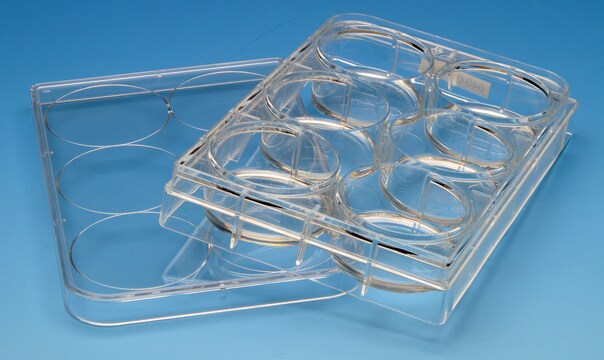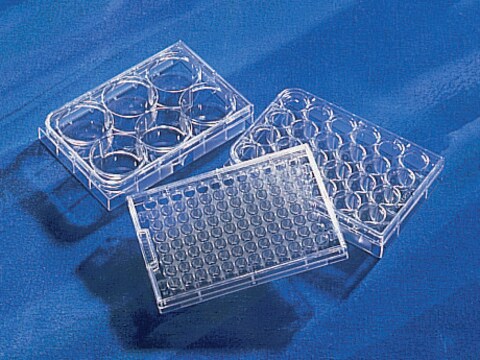CC311
9715 Płytka do obrazowania z 24 dołkami
Elastic Moduli 32 kPa
Zaloguj sięWyświetlanie cen organizacyjnych i kontraktowych
About This Item
Kod UNSPSC:
12352207
NACRES:
NB.15
Polecane produkty
Opis ogólny
Sztywność podłoża komórki (takiego jak macierz zewnątrzkomórkowa) może mieć głęboki wpływ na funkcjonowanie komórki, w tym morfologię, różnicowanie i ekspresję genów. Moduł sprężystości Younga jest właściwością mechaniczną, która mierzy sztywność materiału stałego. Określa on zależność między naprężeniem a odkształceniem w materiale i jest mierzony w kPa. Płytki
9715 zapewniają narzędzie do hodowli komórek na podłożach o określonej sztywności obejmującej szeroki zakres fizjologiczny (0,2 kPa-64 kPa). Na dnie każdej studzienki znajduje się cienka warstwa specjalnie opracowanego biokompatybilnego silikonu, którego moduł sprężystości (sztywność) jest dokładnie mierzony i certyfikowany. Powierzchnie żeli są funkcjonalizowane w celu utworzenia wiązań kowalencyjnych z aminami na białkach. Żel łatwo wiąże się z oczyszczonymi białkami ECM, takimi jak kolagen typu I PureCol (5006), przed dodaniem komórek.
9715 Płytki do obrazowania są przeznaczone do obrazowania w wysokiej rozdzielczości, gdzie wymagana jest niska autofluorescencja i wyjątkowa przejrzystość optyczna. Płytki te umożliwiają zarówno obrazowanie żywych komórek, jak i powszechne techniki utrwalania, takie jak barwienie immunologiczne. Płytka składa się z cienkiej poliwęglanowej płyty dolnej o grubości 175 μm połączonej z czarną polistyrenową ramą i zawiera pokrywę. Płytki są sterylizowane przy użyciu ozonu i dostarczane z 1 płytką w opakowaniu.
Uwaga: Zalecenia te należy traktować jako wytyczne w celu określenia optymalnych warunków powlekania dla danego systemu hodowli. Dno płytki może zostać oderwane przez nadmierną siłę mechaniczną, taką jak wirowanie lub bezpośredni kontakt z narzędziami do przenoszenia cieczy (końcówki, pipety itp.).
1. Wyjąć produkt 9715 z rękawa ochronnego w sterylnym pomieszczeniu.
2. Przygotować materiał macierzy pozakomórkowej, neutralizując go w buforze niezawierającym amin o pH od 7,4 do 7,9 (np. 1X DPBS). Nie zalecamy stosowania żelatyny jako białka ECM. Uwaga: Przed użyciem podgrzać roztwór powlekający do temperatury zbliżonej do pokojowej.
3. Rozcieńczyć w razie potrzeby i dozować 1 ml roztworu do każdego dołka w celu pokrycia powierzchni. Uwaga: Zalecane rozcieńczenie dla kolagenu PureCol typu I wynosi 1:30 (~100 μg/ml). Uwaga: Hydrofobowa powierzchnia wymaga większych objętości do pokrycia powierzchni niż konwencjonalne plastikowe naczynia
4. Inkubować 9715 pokryte ECM w temperaturze pokojowej, pod przykryciem przez 1 godzinę.
5. Po inkubacji odessać pozostały materiał i natychmiast dwukrotnie przepłukać pokryte powierzchnie pożywką hodowlaną lub PBS. Uwaga: Nie dopuścić do wyschnięcia powierzchni 9715 po jej zwilżeniu.
6. Pokryte powierzchnie są gotowe do użycia. Do pobierania komórek z produktu 9715 można stosować standardowe procedury pobierania stosowane do usuwania komórek z naczyń hodowlanych, w tym trypsynę, Accutase i nieenzymatyczne roztwory do usuwania komórek.
9715 jest zastrzeżonym znakiem towarowym Advanced BioMatrix, Inc.
9715 zapewniają narzędzie do hodowli komórek na podłożach o określonej sztywności obejmującej szeroki zakres fizjologiczny (0,2 kPa-64 kPa). Na dnie każdej studzienki znajduje się cienka warstwa specjalnie opracowanego biokompatybilnego silikonu, którego moduł sprężystości (sztywność) jest dokładnie mierzony i certyfikowany. Powierzchnie żeli są funkcjonalizowane w celu utworzenia wiązań kowalencyjnych z aminami na białkach. Żel łatwo wiąże się z oczyszczonymi białkami ECM, takimi jak kolagen typu I PureCol (5006), przed dodaniem komórek.
9715 Płytki do obrazowania są przeznaczone do obrazowania w wysokiej rozdzielczości, gdzie wymagana jest niska autofluorescencja i wyjątkowa przejrzystość optyczna. Płytki te umożliwiają zarówno obrazowanie żywych komórek, jak i powszechne techniki utrwalania, takie jak barwienie immunologiczne. Płytka składa się z cienkiej poliwęglanowej płyty dolnej o grubości 175 μm połączonej z czarną polistyrenową ramą i zawiera pokrywę. Płytki są sterylizowane przy użyciu ozonu i dostarczane z 1 płytką w opakowaniu.
Uwaga: Zalecenia te należy traktować jako wytyczne w celu określenia optymalnych warunków powlekania dla danego systemu hodowli. Dno płytki może zostać oderwane przez nadmierną siłę mechaniczną, taką jak wirowanie lub bezpośredni kontakt z narzędziami do przenoszenia cieczy (końcówki, pipety itp.).
1. Wyjąć produkt 9715 z rękawa ochronnego w sterylnym pomieszczeniu.
2. Przygotować materiał macierzy pozakomórkowej, neutralizując go w buforze niezawierającym amin o pH od 7,4 do 7,9 (np. 1X DPBS). Nie zalecamy stosowania żelatyny jako białka ECM. Uwaga: Przed użyciem podgrzać roztwór powlekający do temperatury zbliżonej do pokojowej.
3. Rozcieńczyć w razie potrzeby i dozować 1 ml roztworu do każdego dołka w celu pokrycia powierzchni. Uwaga: Zalecane rozcieńczenie dla kolagenu PureCol typu I wynosi 1:30 (~100 μg/ml). Uwaga: Hydrofobowa powierzchnia wymaga większych objętości do pokrycia powierzchni niż konwencjonalne plastikowe naczynia
4. Inkubować 9715 pokryte ECM w temperaturze pokojowej, pod przykryciem przez 1 godzinę.
5. Po inkubacji odessać pozostały materiał i natychmiast dwukrotnie przepłukać pokryte powierzchnie pożywką hodowlaną lub PBS. Uwaga: Nie dopuścić do wyschnięcia powierzchni 9715 po jej zwilżeniu.
6. Pokryte powierzchnie są gotowe do użycia. Do pobierania komórek z produktu 9715 można stosować standardowe procedury pobierania stosowane do usuwania komórek z naczyń hodowlanych, w tym trypsynę, Accutase i nieenzymatyczne roztwory do usuwania komórek.
9715 jest zastrzeżonym znakiem towarowym Advanced BioMatrix, Inc.
Przechowywanie i stabilność
Przechowywać płytki CytoSoft Imaging w temperaturze pokojowej.
Informacje prawne
CytoSoft is a registered trademark of Advanced BioMatrix, Inc.
Oświadczenie o zrzeczeniu się odpowiedzialności
O ile nie określono inaczej w naszym katalogu lub innej dokumentacji firmy dołączonej do produktu(-ów), nasze produkty są przeznaczone wyłącznie do użytku badawczego i nie mogą być wykorzystywane do żadnych innych celów, w tym między innymi do nieautoryzowanych zastosowań komercyjnych, zastosowań diagnostycznych in vitro, zastosowań terapeutycznych ex vivo lub in vivo lub jakiegokolwiek rodzaju konsumpcji lub zastosowania u ludzi lub zwierząt.
Ta strona może zawierać tekst przetłumaczony maszynowo.
Kod klasy składowania
13 - Non Combustible Solids
Klasa zagrożenia wodnego (WGK)
nwg
Temperatura zapłonu (°F)
Not applicable
Temperatura zapłonu (°C)
Not applicable
Certyfikaty analizy (CoA)
Poszukaj Certyfikaty analizy (CoA), wpisując numer partii/serii produktów. Numery serii i partii można znaleźć na etykiecie produktu po słowach „seria” lub „partia”.
Masz już ten produkt?
Dokumenty związane z niedawno zakupionymi produktami zostały zamieszczone w Bibliotece dokumentów.
Nasz zespół naukowców ma doświadczenie we wszystkich obszarach badań, w tym w naukach przyrodniczych, materiałoznawstwie, syntezie chemicznej, chromatografii, analityce i wielu innych dziedzinach.
Skontaktuj się z zespołem ds. pomocy technicznej


